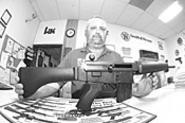The rifle sits with its belly exposed on a display shelf in Titlow's shop, next to a sign that reads, "Like it? Let us finance it!" But none of his customers are interested. Now that the federal ban on assault weapons has ended, Titlow's rifle is obsolete. "I'm getting 10 calls a day from people wanting to know when I'm gonna get my new rifles in," Titlow says. The phone behind the counter rings. "See? There's another one!"
The law, passed by Congress in 1994, didn't actually make assault rifles illegal. Rather, it banned modifications that make rifles easier to conceal, and it outlawed clips capable of holding more than 10 bullets. The law was scheduled to expire in 2004, unless Congress voted to extend it. That deadline came and went on September 13. Now that more assault rifles are legal, gun-control advocates warn of bloodbaths in the streets. "These are weapons of war," says Eric Howard, spokesman for the Brady Campaign to Prevent Gun Violence. "These are military weapons that switch the balance of power to the lawless."
The problem, however, is that the ban was nearly worthless. During the entire decade it was in effect, anyone -- gun collectors, criminals, terrorists -- could still buy assault rifles legally. And it's not just National Rifle Association gun nuts saying so. "No, the end of the ban won't make any difference at all," says Eastlake Police Lieutenant Tom Doyle, a 33-year veteran of the force. "I'm not a big NRA supporter. But if you want to go and shoot up a mall, you could always buy an AK-47 that was legal during the ban and do what you want."
What's the difference between a rifle that was legal under the ban and one that was illegal? Not much. First, the law banned rifles with flash suppressors. Whenever a gun is fired, flame shoots from the muzzle. This puts soldiers fighting at night in danger, because it allows enemies to pinpoint their location. So the military created flash suppressors to disperse the flame.
Second, the ban imposed limits on stocks -- the part of the rifle that rests against the shooter's shoulder. Some weapons have folding stocks to make them easier to conceal. And in the early 1990s, gangbangers used folding stocks to hide rifles in their coats. "Ten years ago, this ban was the right thing to do," says Jim Pasco, executive director of the national Fraternal Order of Police. Pasco lobbied for the law on behalf of the Bureau of Alcohol, Tobacco and Firearms.
Finally, the ban barred all clips capable of holding more than 10 bullets. Larger clips -- also known as magazines -- allow gunmen to shoot more bullets before reloading, the reasoning went. So limiting clip sizes would slow criminals down and give potential victims time to escape.
On its face, the law made sense. Assault rifles with flash suppressors, folding stocks, and long magazines are designed for one thing: sneaking up on people and killing them. "We believe the weapons that are now available are not necessarily used for hunting or sport," says Lieutenant Wayne Drummond, Cleveland Police Department spokesman. "Assault weapons are used by the armies of the world to kill."
But the ban was an utter failure. That's largely because all rifles with flash suppressors and folding stocks were perfectly legal to buy during the ban, just as long as they were manufactured before the law took effect. Large clips made before the ban were legal, too. So gun manufacturers churned out enormous stockpiles of pre-ban rifles and clips, and continued selling "banned" weapons for the entire decade that the law was in effect. "It's like Prohibition," Titlow says. "The only thing the ban did was make these things more desirable, so the prices went up. But as long as you had the money, it was always legal to buy one."
Over time, the ban did have a small effect on criminal behavior. The number of assault rifles recovered at crime scenes dropped 66 percent from 1994 to 2001, according to ATF data. But before the ban, just 4.8 percent of all crime guns were assault rifles, which means that they were never the weapon of choice for most criminals.
Gun-control advocates also point to the recent takeover of a Russian school by Chechen separatists, who used large-magazine assault weapons to hold 1,100 children hostage. Such an attack was more difficult to stage under the rifle ban, critics say, because reloading 10-round magazines would have slowed the terrorists down. "It takes about a second to reload," says Howard. "A second is huge. A second gives victims enough time to duck."
"That's nonsense," says Dr. Neil Livingstone, a terrorism expert and former adviser to the U.S. Secretary of State. "To take over a school, you have to be prepared to die. If you're prepared to do that, buying illegal weapons is the least of your concerns."
The law's impact on terrorists was minuscule. Its impact on politics was huge. Democrats believe it cost them control of Congress in 1994. The ban has been the perfect fund-raising tool for the gun lobby, which pumped more than $18 million into congressional races since 1997 (of that, 94 percent went to Republicans). "A lot of Democrats are very leery of having a fight on guns," says FOP leader Pasco. "Gun control is used very cynically, by both sides, for political advantage."
The end of the ban leaves Jim Titlow in a bind. He has three rifles, hundreds of 10-round clips, and no customers. But he does have a number of new weapons on order. He also has his own personal stockpile. "I own three [pre-ban rifles]," Titlow says. "The ban got me into it. I wanted to check them out. As a collector, they were a worthwhile investment."














